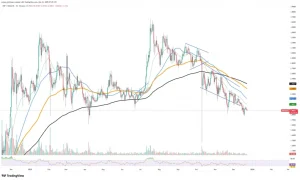Galaxy Digital Lowers Bitcoin Outlook for 2025, Calling It the Dawn of a “Maturity Era”

In a significant recalibration, Galaxy Digital has reduced its 2025 price target for Bitcoin from US $185,000 to US $120,000, citing the cryptocurrency’s transition into a new phase of evolution—what it terms the “maturity era.” This adjustment reflects changing market dynamics driven by institutional participation, moderated volatility, and large-scale selling by long-term holders. While Galaxy remains optimistic about Bitcoin’s long-term value proposition, it warns that the pace of growth will likely slow as the asset matures into a more stable and structurally integrated component of the global financial ecosystem.
1. A Shift in Expectations: From Aggressive Growth to Sustainable Expansion
Galaxy Digital’s revised forecast underscores a notable cooling in Bitcoin’s speculative momentum. The firm attributes this downward revision to a confluence of market realities: declining volatility, institutional dominance, and a recent wave of profit-taking by large holders. Analysts suggest that Bitcoin is entering a period of stabilized growth, where gains are less parabolic but more durable.
The adjustment from US $185,000 to US $120,000 does not imply a loss of faith in the cryptocurrency’s fundamentals. Instead, Galaxy’s research division emphasizes that Bitcoin is progressing beyond its early hyper-growth stage—shifting toward a more measured trajectory consistent with its maturation as a mainstream financial asset.
2. The “Maturity Era”: A New Market Regime
According to Galaxy, Bitcoin’s current phase represents the “maturity era”—a transformation marked by reduced speculative fervor and increasing institutional participation. The influx of regulated funds, exchange-traded products, and corporate treasuries has begun to reshape the asset’s behavioral profile.
This period is characterized by:
- Lower volatility, as long-term investors replace short-term traders.
- Greater liquidity discipline, driven by professional money managers rather than retail speculation.
- A slower but steadier price discovery process, as Bitcoin becomes embedded in diversified portfolios.
In essence, Bitcoin is behaving less like a high-risk, frontier asset and more like an established store of value—akin to gold or long-duration equities, albeit still prone to periodic corrections.
3. Recent Market Pressures and the Role of Whale Activity
The firm’s revised outlook follows weeks of selling pressure that saw long-term holders—often referred to as “whales”—offload roughly 400,000 BTC, valued at nearly US $45 billion (≈ Rs. 3.7 lakh crore). This large-scale distribution has weighed heavily on prices, sending Bitcoin below US $100,000 for the first time since mid-year.
While previous downturns were largely caused by leveraged liquidations, this episode appears different. The selling has been deliberate, not panic-driven, signaling that seasoned investors are rebalancing portfolios rather than abandoning the asset. This shift indicates that the market is becoming more strategically rational, though also less susceptible to the euphoric surges that once defined Bitcoin’s bull runs.
4. Institutionalization and the Changing Nature of Bitcoin Demand
One of the defining features of this new era is the growing institutionalization of crypto investing. Bitcoin’s price performance is now increasingly tied to institutional inflows, particularly from asset managers and exchange-traded funds.
However, Galaxy analysts note that institutional dominance comes with its own challenges:
- Capital flows are often slower and more measured, reducing sharp upward moves.
- Regulatory scrutiny introduces periodic uncertainty.
- The rise of alternative digital assets—such as tokenized real-world assets and stablecoins—creates competition for investor capital.
Still, these changes also provide long-term stability, making Bitcoin less vulnerable to speculative bubbles and flash crashes.
5. Broader Market Implications: A Repricing of Expectations
Galaxy’s forecast reduction should be viewed within a broader context of market normalization. After a decade defined by exponential gains and extreme volatility, Bitcoin’s transition to a more predictable asset class may ultimately attract a new breed of investors—those seeking long-term, risk-adjusted returns rather than speculative windfalls.
Analysts believe that this “re-rating” will help integrate Bitcoin more deeply into traditional finance, encouraging pension funds, sovereign wealth managers, and corporates to treat it as a strategic hedge rather than a speculative gamble. In that sense, a slower price trajectory may be a sign of strength rather than weakness.
6. Long-Term Perspective: Slow Growth, Enduring Relevance
Despite trimming its 2025 target, Galaxy remains firmly bullish on Bitcoin’s future. The company sees structural adoption, technological resilience, and macroeconomic relevance as enduring catalysts. The firm expects Bitcoin to continue benefiting from its scarcity, decentralization, and recognition as “digital gold.”
In the medium term, analysts anticipate consolidation between US $85,000 and US $110,000, followed by gradual appreciation as institutional flows stabilize and global liquidity conditions improve. While the days of overnight 50% rallies may be behind, the long-term thesis remains unchanged: Bitcoin continues to evolve as one of the most significant financial innovations of the 21st century.
Conclusion
Galaxy Digital’s decision to lower its Bitcoin target represents a pragmatic acknowledgment of the asset’s maturation. The cryptocurrency is no longer defined by speculative mania but by structural growth, institutional confidence, and disciplined capital behavior. The so-called “maturity era” marks a new chapter—one in which Bitcoin sheds its reputation as a volatile disruptor and takes its place as a permanent fixture in the global financial landscape.




